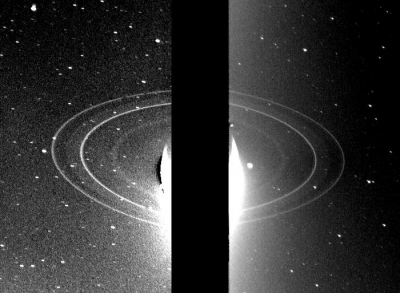
If we are asked to name a planet in the solar system that has rings around it, our answer would be Saturn, perhaps nine out of 10 times. Even if we are asked to just imagine a planet with rings, most of us would likely be thinking of Saturn. This is because we strongly associate Saturn with its rings.
This doesn’t mean, however, that Saturn is the only planet in the solar system that has rings. On the contrary, every gas giant in the solar system – Jupiter, Saturn, Uranus, and Neptune – has a ring around it.
Historic Neptune flyby
Among these, it was Neptune’s rings that were the last to be discovered. While scientists suspected for some years that Neptune must have rings around it, it was only when Voyager 2 made its flyby that it was proven beyond any doubt.
Launched in August 1977, Voyager 2 took 12 years to get to Neptune, having observed Jupiter, Saturn, and Uranus along the way. And then, in a matter of weeks, Voyager 2 discovered six new moons and four rings around Neptune.
Even though Voyager 2 had completed five planetary encounters before heading to Neptune, the big blue planet posed certain specific challenges. Thirty times farther from the sun than Earth is, and receiving just one-thousandth the amount of sunlight that Earth does, there was low light in this region.
Light and distance
This meant that Voyager 2’s cameras required longer exposure to get good quality images during the flyby. Long exposures, however, would have made the images blurry as the spacecraft reached speeds up to 90,000 kmph relative to Earth. To counter this, Voyager 2’s team programmed the spacecraft to fire its thrusters gently during close approach, enabling it to keep the camera focussed on its target, without compromising on the spacecraft’s speed and direction.
Apart from the lighting, the huge distance meant that radio signals reaching Earth from Voyager 2 were weaker than those from other flybys. Voyagers (both 2 and 1), however, communicated with Earth via the Deep Space Network (DSN). The DSN made use of antennas in Madrid, Spain; Canberra, Australia; and Goldstone, California, the U.S.
While the three largest DSN antennas were 64m wide during Voyager 2’s encounter with Uranus in 1986, the dishes were expanded to 70m to assist communication during the Neptune flyby. Other non-DSN antennas were also employed as an auxiliary measure, ensuring that the spacecraft could send back more pictures in a reliable manner within any time-frame.
Daily updates
With no Internet to allow the entire world to see the pictures at the same time, the images were available in real time in only a few locations. As the excitement was palpable world over regarding the Neptune flyby, the team behind Voyager 2 decided to provide public updates as often as possible, leading to daily press conferences from August 21-29, 1989.
On August 22, 1989, Voyager 2 provided the images that serve as the definitive discovery of Neptune’s rings. A few days later, the spacecraft made its closest approach to Neptune. After successfully completing another planetary encounter, Voyager 2 headed off on its interstellar exploratory voyage.
Five main rings
We now know that Neptune has at least five main rings and four prominent ring arcs. Starting from the ring nearest to the planet, these are named Galle, Leverrier, Lassell, Arago, and Adams.
While the rings are currently thought to be short-lived and relatively young, the arcs are clumps of dust that are peculiar to Neptune’s ring system. The outermost ring, Adams, is where four prominent arcs Liberty, Equality, Fraternity, and Courage can be found.
Even though the laws of motion predict that these arcs would be spread out evenly, they actually stay clumped together, making them unusual. While we don’t yet know for certain, scientists suggest that the gravitational effects of Galatea, a moon just inward from Adams, is probably what stabilises these arcs. There’s this, and more, to find out and learn from the rings of Neptune.
Picture Credit : Google




